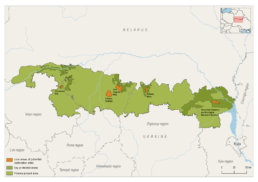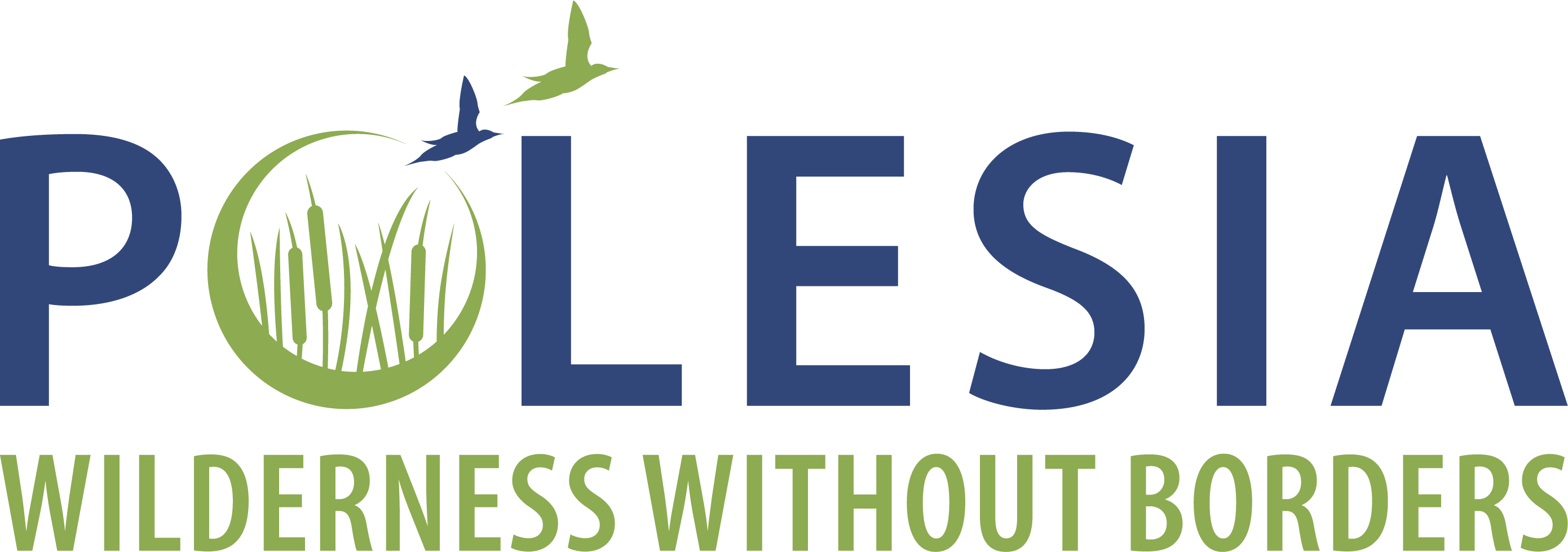Almany Mires
The Almany Mires Nature Reserve is a vast area of swampland located between three right tributaries of the Pripyat River – the Garyn, the Scviga and the Lva. It is Europe’s largest cross-border wetland of its kind, and it has remained in a natural state, with very little interference from people.
About 90% of the reserve is untouched or only slightly changed. Half of the area is covered by forests (many of which grow on bogs), 40% is open peat bogs, and 5% is rivers and lakes.
The area features two large open transitional and lowland wetland complexes, Galo and Krasnaje, as well as other bogs. The forests are mostly pine and birch, with over half of which grow in bogs. There are also significant areas of oak forests along the Scviga River.
Because it’s so big and hard to get to, the Almany Mires acts as a perfect natural refuge for plants and animals that are threatened elsewhere in their natural environment. Nature takes care of itself here, without the need for expensive conservation measures.

Country: Belarus
Area: 103,935.0 ha
National protection status: National Nature Reserve
International protection status: Ramsar site (1091) – Olmany Mires Zakaznik (94,219 ha); IBA (BY018) – Al'manskija baloty (96,628 ha); Emerald Network* (BY000012) – Olmanskiye bolota (93,135 ha).
* After denunciation of accession to the Bern Convention on the Conservation of European Wildlife and Natural Habitats, de jure there are no Emerald Network sites in Belarus.
90%
of natural
or slightly modified areas
20 key habitats
included in Resolution #4
of the Standing Committee
to the Bern Convention
>80 rare species
with national or international protection status
Land cover

Forests

Open peatbogs

Rivers and waterbodies

Others
Biodiversity and natural values

Habitats
The area represents a unique forest and mire complex with an exceptional richness of wetland and forest habitats. About 20 habitats requiring specific protection under the Resolution No. 4 of the Standing Committee to the Bern Convention have been identified here, and the area is particularly important for their conservation in Belarus:
Wetlands
- Transitional Mires and Quaking Bogs (7140),
- Raised Bog Complexes (7110),
- Beds of Large Sedges;
Aquatic habitats
- Permanently Dystrophic Lakes, Ponds and Pools (3160),
- Free-floating Vegetation of Eutrophic Waters (3150);
Forests and Woodlands
- Riverine Willow Forests (91Е0), Riverine Ash-Alder Forests (91Е0),
- Mixed Oak, Elm and Ash Woods of Large Rivers (91F0),
- Oak, Ash and Hornbeam Woods (9170),
- Sphagnum Birch Woods (91D0), Nemoral and Boreal Coniferous Woods (91D0);
Other Terrestrial Habitats
- Inland Sand Dunes (2330).



Mammals
There are a few species of mammals rare in Belarus recorded here, such as the Lynx (Lynx lynx) and the Badger (Meles meles). The more common mammal species are the Beaver (Castor fiber), the Otter (Lutra lutra), the Moose (Alces alces) and the Wolf (Canis lupus). The Almany peat bog is one of the last habitats of the European Mink (Mustela lutreola).

Birds
The reserve’s avifauna includes more than 20 species under national protection and mo-re than 40 under international protection. The largest European population of the Greater Spotted Eagle (Aquila clanga) nests here, as well as the largest Belarusian populations of the Short-toed Eagle (Circaetus gallicus) and the Crane (Grus grus), the Great Grey Owl (Strix nebulosa), the Greenshank (Tringanebularia), the Three-toed Woodpecker (Picoides tridactylus), the White-backed Woodpecker (Dendrocopos leucotos), the Aquatic Warbler (Acrocephalus paludicola) and a number of other species.
More than 80 species included in Resolution No. 6 of the Standing Committee to the Bern Convention and the Red Data Book of Belarus have been recorded here.

The most important impacts and threats

Logging

Dead wood removal

Old drainage systems
Protection and conservation needs
The area is protected as a landscape reserve of national importance, where many economic activities are restricted, including drainage, construction, logging and others. Some of protected species’ habitats identified here have been passed under protection of land users. A management plan has been developed for the area. Experts suppose that the following measures could improve the protection of this valuable area:
- Compile a detailed inventory of the conservation values (species habitats and biotopes);
- Ensure the protection of natural values by establishing special protection zones/plots (the zoning of the reserve is appropriate, with demarcation of the strict protection zones and total prohibition of all economic activities in them);
- Restrict artificial afforestation/reforestation and infrastructure construction.
Our activities in the area
As part of the project, the area of the Reserve was increased by 9,716 ha (about 10% of its initial area), a management plan for the reserve was developed and approved. Eco-tourism and fire-fighting equipment was purchased and handed over to the reserve staff. Camp sites for tourists and berry pickers have been established.



The project “Polesia – Wilderness Without Borders” is part of the Endangered Landscapes & Seascapes Programme and is funded by Arcadia. The project is coordinated by Frankfurt Zoological Society (FZS).

